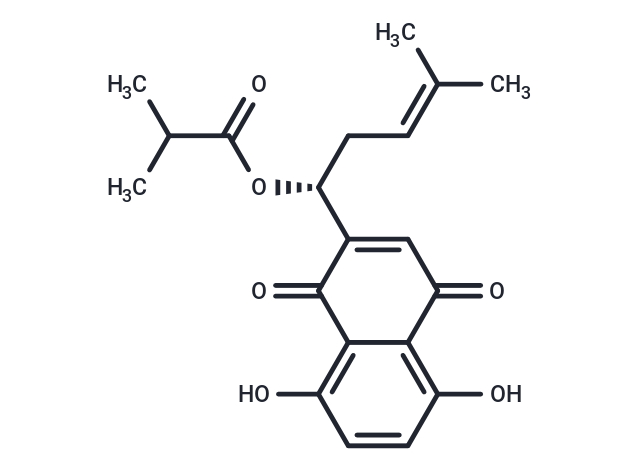Shopping Cart
- Remove All
 Your shopping cart is currently empty
Your shopping cart is currently empty

Isobutylshikonin exhibits obvious antioxidant activities , it exerts very good radical scavenging activities toward ABTS+ but shows moderate inhibition of DPPH·.

| Pack Size | Price | Availability | Quantity |
|---|---|---|---|
| 1 mg | $85 | In Stock | |
| 5 mg | $198 | In Stock | |
| 10 mg | $293 | In Stock | |
| 25 mg | $495 | In Stock | |
| 50 mg | $719 | In Stock | |
| 100 mg | $987 | In Stock |
| Description | Isobutylshikonin exhibits obvious antioxidant activities , it exerts very good radical scavenging activities toward ABTS+ but shows moderate inhibition of DPPH·. |
| In vitro | Five red shikonin pigments, deoxyshikonin, shikonin, acetylshikonin, Isobutylshikonin, and beta-hydroxyisovalerylshikonin, were isolated from the roots of Lithospermum erythrorhizon cultivated in Korea. The purified pigments were red, purple, and blue at acidic, neutral, and alkaline pH values, respectively. Physical stability of the purified pigments against heat and light in an aqueous solution was examined for possible value-added food colorants. The thermal degradation reactions were carried out at pH 3.0 (50 mM glycine buffer) in 50% EtOH/H(2)O. Deoxyshikonin (t(1/2) = 14.6 h, 60 degrees C) and isobutylshikinin (t(1/2) = 19.3 h, 60 degrees C) are relatively less stable than other shikonin derivatives (t(1/2) = 40-50 h, 60 degrees C). Activation energies of thermal degradation of the isolated pigments were calculated. The activation energy of deoxyshikonin was the highest (12.5 kcal mol(-)(1)) and that of beta-hydroxyisovalerylshikonin was the lowest (1.71 kcal mol(-)(1)) value[1] |
| Molecular Weight | 358.39 |
| Formula | C20H22O6 |
| Cas No. | 52438-12-7 |
| Smiles | CC(C)C(=O)O[C@H](CC=C(C)C)C1=CC(=O)c2c(O)ccc(O)c2C1=O |
| Relative Density. | 1.269 g/cm3 (Predicted) |
| Storage | keep away from direct sunlight,keep away from moisture | Powder: -20°C for 3 years | In solvent: -80°C for 1 year | Shipping with blue ice. |
| Solubility Information | DMSO: Slightly soluble |

Copyright © 2015-2024 TargetMol Chemicals Inc. All Rights Reserved.